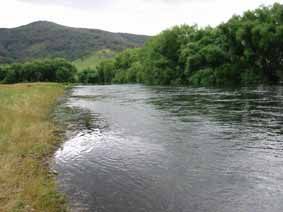Major Group: Insecta
Order: Trichoptera
Family: Odontoceridae |
| Descriptive Features: head may be flattened and with a ridge (carina) or large and rounded
antennae situated close to the anterior margin of the head, minute
ventral apotome reaching to the back of the head or with a ventral suture
pronotum sclerotized, prosternum almost completely sclerotised or with 2 smaller sclerites
mesonotum sclerotised, mesonotum may appear to be divided into 3 sclerites
metanotum with 4 sclerites covering most of the segment or numerous small sclerites, metasternum with or without sclerites
abdominal segment 1 ventrally with 2 or numerous setae
tergite 9 very pale if present, with 2-4 long pairs of setae
anal claw particularly long, with dorsal spine-like setae and with or without small dorsal teeth
Total length: 10 – 20 mm
Early instar larvae: Very difficult to distinguish from early instar Philorheithridae as the latter do not have the characteristic fusion of the mid tibia and tarsus. Barynema has spines (as distinct from dorsal teeth) present on the anal claw from first instar.
Case: Tubular, made of sand grains and fine gravel, often over 2 cm long. |

|
|
| |
| Taxonomic Checklist: Genera
Barynema
Marilia |

|
|
| |
Distribution: Qld, NSW, Vic, Tas
Sensitivity Rating: SIGNAL grade 7
Functional Feeding Group: shredders
|

|
|
Ecology: Instream habitat: Odontocerid larvae appear to be confined to rapidly flowing upland streams, sometimes in backwaters, of wetter regions. Barynema costatum larvae are collected under larger stones overlaying or embedded in coarse sand.
Feeding ecology: Larvae are probably shredders or scrapers, but some species may be opportunistic scavengers feeding on animal and plant detritus. Odontocerid larvae have never been observed actively hunting.
Habit: Larvae construct tubular cases from coarse grains of sand, slightly curved and tapering posterior.
Life history: Final instar larvae seal themselves inside their cases to begin pupation. Pupae of Barynema costatum may be collected in April to October. This suggests that this species over winters in the pupal stage to emerge in spring. |
|
| |
| Information Sources: St Clair 2000a, Dean et al 2004, Williams 1980, Dean et al 1995 Neboiss 2003, Gooderham & Tsyrlin 2002 |
More ››› key to genera 
|
|